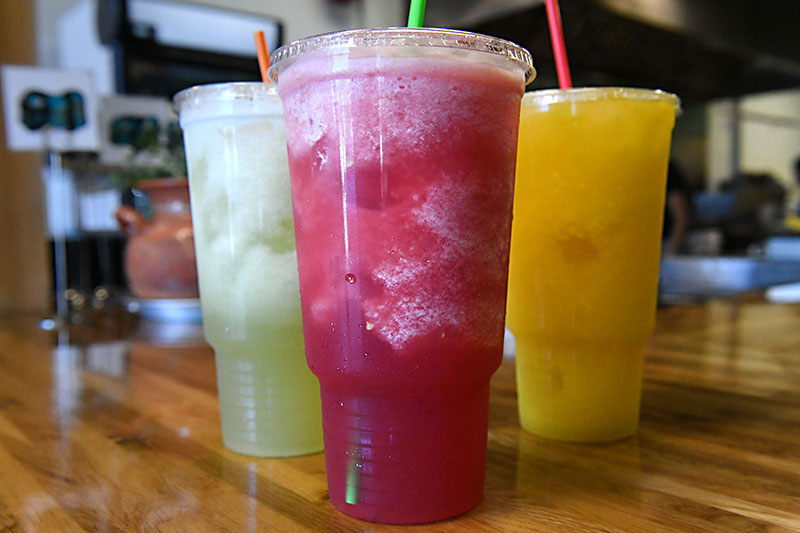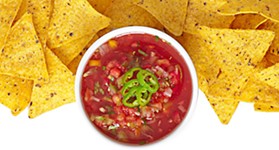Viva Aguas Frescas
The Mexican refreshers: how to make them, and where to find them in Austin
By Sierra Diaz, Fri., July 14, 2017
Those of us who grew up in Texas know that much of the local cuisine has its origins in Mexico. Long before they became trendy, aguas frescas were ubiquitous among many Mexican families, like mine. In El Paso, where I'm from, drinking aguas frescas is something of an unwritten law, made easier by the variety of flavors that can be found just about anywhere.
Often, my family and I would take trips to Juárez, Mexico, the border city to El Paso, where we would spend our days at various mercados looking at homemade goods, grabbing a few tacos and a refreshing melon drink to cool down. After church on Sundays, we'd pair our enchiladas with a sweet horchata. And grocery shopping was always memorable because the lineup of vitroleros (the traditional beehive-shaped glass jars) filled with different flavors and colors gave us something to look forward to.
But the history of the beverage began long before us. Literally translated as "fresh waters," these drinks go as far back as the pre-Columbian 15th century, when the Aztecs would journey from their farmlands to Tenochtitlan (now known as Mexico City) to buy goods at the markets. During these voyages, they would collect fruit and muddle them into water to create a hydrating beverage.
Now, aguas frescas can be found at almost any Mexican street stand, market, or restaurant. Over time, recipes have become unique to each family as different ingredients were incorporated. Typically, they are made with seasonal fruits, but can also be made using seeds, grains, nuts, herbs, and flowers to create any flavor combination you can imagine. Perhaps the most well-recognized variety is cinnamon-flavored horchata. While the original recipe calls for rice, you can substitute oats, barley, almonds, or coconut. The traditional water base can be replaced with whole milk, sweetened condensed milk, or evaporated milk.
The ingredients make aguas frescas perfect for summer. They're light on the tongue and though sweet, the sugar does not overwhelm. Whether you're out by the pool or cooking up carne asada, aguas frescas are perfect zero-proof alternatives to margaritas. But if you want the extra boost, feel free to add booze. Far be it from us to judge you.
WHERE TO GET IT
Fresa's Chicken al Carbon
Serving up a modern twist on Mexican classics, Fresa's tacos and wood-grilled meals – like their Yucatán spice chicken – are a perfect pairing with their bright limón and sandía flavors.
El Chilito
This Tex-Mex is our go-to when we're in a hurry – offering an assortment of tacos, migas, and barbacoa soup. While we wait, we like sipping on an ojo rojo, an horchata mixed with a shot of espresso.
La Fruta Feliz
One bite of La Fruta's pork (Cubana) or steak (Milanesa) tortas will make you forget all the chain sandwich places. Wash them down with melon, fresa, or mango.
Rosita's Al Pastor
This food trailer is famous for serving Mexican street food to the Eastside, and their Taco al Pastor is (obviously) their most popular item. Even better, their drink flavors rotate so there's something new every visit.
El Taquito
Another classic spot in East Austin (with a can't-miss queso fundido), El Taquito is our secret when we have to feed a crowd. Their 5-gallon aguas jugs come in hard-to-find flavors like tamarind.
Papalote
Papalote's two locations keep their bebidas classic, offering hibiscus, tamarind, and horchata flavors to cut down their fiery salsa's spice.
Veracruz All Natural
The famous migas make the headlines, but we think their drinks need a little press. Their large batches of interesting flavors like cantaloupe, strawberry/banana, or cucumber are our secret party hack.
HOW TO MAKE IT
Tips
• Use ripe fruit that's in season. The area farmers' markets will always have some interesting options.
• The drink is most commonly sweetened with pure cane sugar, but agave and honey make good alternatives.
• Avoid using ice cubes that would dilute the drink. Instead, freeze the drink in ice cube trays before a party and add those to the mix.
Agua de Sandía
Ingredients:
4-5 cups seedless watermelon, peeled and cubed
1 cup pure cane sugar (use more or less according to taste)
1-3 cups water (can skip for a more concentrated drink)
Mint and lime to taste (optional)
Directions: Add watermelon and water into blender and blend at a high speed until smooth. Add sugar to taste. Strain to remove pulp. Add mint or lime (if using) and pour over ice.
Agua de Melón
Ingredients:
4-5 cups cantaloupe, peeled and cubed
1 cup pure cane sugar (use more or less according to taste)
3-5 cups water
1 can evaporated milk
Directions: Add cantaloupe into blender with water and evaporated milk. Blend until fine and strain. Add additional water if needed and pour over ice.
Agua de Limón y Pepino
Ingredients:
3 large cucumbers, peeled and chopped
½ cup lime juice
4-5 cups water
¼ cup sugar (to taste)
Directions: Blend ½ cup of water with 1 cup of chopped cucumber into blender. Continue to add cucumber until all cucumbers are used and smooth. Strain the mixture and add remaining water, sugar, and lime juice to taste. Pour over ice or chill before serving.
Agua de Jamaica
Ingredients:
½ cup dried hibiscus flowers
1 cup pure cane sugar (to taste)
2-3 cups water
Directions: Bring water to a boil. Pre-rinse and add flowers into boiling water. Immediately take off heat and cover. Steep for about 10 minutes. After steeping, strain and press to extract juices. Add additional water and sugar to taste and cool.
Agua de Horchata
Ingredients:
2 cups long-grain white rice
1 Mexican cinnamon stick
½ to 1 tablespoon vanilla extract
3-5 cups water
½ cup whole milk (low-fat milk or a milk alternative can be substituted)
to ½ cup pure cane sugar (to taste)
Directions: Place rice, water, and cinnamon stick in a bowl and let soak for 24 hours. After soaking, blend mixture and add milk, sugar, and vanilla. Strain a few times and serve over ice.









